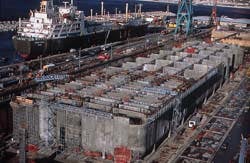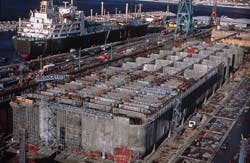France Concrete barge set for 30-year assignment on N'Kossa
Durability and fatigue resistance sway choice of material for Elf Congo development
C.Valenchon
R.Nagel
Bouygues OffshoreJ.Viallon
H.Belbeoc'h
BouyguesJ.Rouillon
Elf Congo
N'Kossa barge under construction in drydock at Marseilles.
On August 18, 1993, Elf Congo awarded the contract for the design and construction of the hull of the N'Kossa production barge to the Bouygues Offshore-Bouygues joint venture. The award followed an international call for tender for a steel hull. Bidders were allowed to propose a concrete-based alternative.
The contract comprises the design, procurement and construction of the hull and marine equipment (mooring system, ballasting and safety systems). The design has been completed and the construction is now in progress, being carried out by the Bouygues Offshore-Bouygues JV in drydock at Marseilles, France.
Development concept
N'Kossa field development consists of two steel fixed drilling platforms, a production barge and, for export, two storage/loading vessels, one for oil and one for LPG. Once operational at the N'Kossa Field, the barge and its 30,000 tonnes of equipment will house 160 people, serve as control center for the other installations and provide:
- oil treatment-separation and desalination (18,500cu m/d) or 116,000b/d
- production of LPG (1,300t/d)
- electric power generation and distribution (3 x 25MW)
- dehydration and condensate extraction (13 MMcum/d or 460 MMcf/d
- gas reinjection (11 MMcum/d at 42MPa or 390 MMcf/d at 6,100psi)
- water injection (18,000cu m/d at 24.5MPa or 113,000b/d at 3,550psi).
The barge production equipment is grouped into six modules which are currently under construction in three different yards around Europe. After completion, they will be transported to an assembly site where they will be installed on the hull, and the hook-up and commissioning activities will be carried out. The completed vessel will then be towed to the N'Kossa site and moored there in 170 m water depth, adjacent to one of the drilling platforms.
Although the barge will store consumables (fuel, industrial water) and chemical products, it will not store the produced hydrocarbons.
The concrete barge is expected to fulfil its functions on site without interruption for 30 years. This aspect was decisive in Elf Congo's choice of a concrete barge, due to the excellent durability of concrete in the marine environment as well as its good fatigue resistance.
Why concrete?
Compared to a steel hull, pre-stressed concrete offers some distinct advantages for offshore production vessels in a fixed location:
- simple hull structural design, which easily satisfies all design requirements and supports large topsides weight
- long tradition of concrete as a construction material for marine environment with design and construction techniques well established
- reinforced concrete is fatigue resistant and durable. This, combined with the simple structural design of the hull, makes inspection and maintenance easy
- a concrete hull is stiffer than an equivalent steel hull
- the sides of a concrete hull are able to withstand without damage significant impact loads from supply boats
- concrete structures have better fire resistance than steel structures, which is of major importance for an oil production vessel.
Hull features
The hull of the N'Kossa barge is of rectangular shape, 220 meters long, 46m wide and 16m high. The bottom is 45cm thick, the sides 50cm and the deck 40cm thick. The hull is stiffened by a system of bulkheads: a central bulkhead with openings, two watertight longitudinal bulkheads on either side of the central bulkhead and 12 transverse watertight bulkheads.
These watertight bulkheads divide the hull into 35 dry compartments and four ballastable units. This arrangement satisfies the stability criteria. The bulkheads and slabs are designed to resist the hydrostatic and hydrodynamic pressures. They are gusseted around the periphery but have no local stiffeners. The deck of the barge is stiffened by beams allowing it to support the load of the modules during load-out and in service.
N'Kossa's barge is highly pre-stressed with a network of orthogonal cables composed of 12 or 19 strands, 15mm dia., situated in all plane elements. Pre-stressing has been designed so that there will be no exterior anchors either under water or in the splash zone, to avoid any danger of corrosion. The chines of the barge are rounded to avoid pre-stress anchors in these relatively vulnerable areas.
Horizontal keels at the level of the bottom slab will reduce considerably the roll of the barge. Their efficiency was confirmed by a series of tank tests. Access to the various holds is provided from a central tunnel via a system of watertight portholes. A ventilation system is provided for safety. The barge is equipped with a ballasting/deballasting system allowing adjustment of the heel and trim angles of the vessel to compensate the actual center of gravity.
The barge is permanently anchored in 170m water depth by twelve 4.5in. chains in groups of three at each corner of the vessel. All immersed protruding steel elements are cathodically protected by a system of sacrificial anodes. The amount of anodes is calculated by taking into account an allowance for current drainage to the reinforcement.
Concrete choice
Several reasons led Bouygues to select high performance concrete with a 70MPa characteristic compressive cylinder strength as a material for the hull, and more particularly:
- the ability to minimize concrete quantities due to the high strength of this type of concrete
- the excellent durability of HPC in a marine environment
- the highly fluid rheology of freshly mixed HPC allowing high quality casting of the concrete without segregation in highly reinforced areas
- the high strength of the concrete at an early age allowing reduction of construction time due to rapid turnover of reusable formworks.
On site, concrete is mixed by two batching plants, transported by mixing trucks, and cast in place by means of pumps for the bottom slab, and pumps with long vertical tubes to cast 15m high sides and bulkheads in one go. For this purpose, and because of the high density of reinforcement and pre-stressing, the concrete has 16mm maximum aggregate diameter and has to be fluid: the slump-test is up to 22cm during more than one hour after mixing.
At the drydock in Marseilles, in order to lodge the pre-stress cable loops, the bottom of the barge is designed with 30cm deep ribs. After drying out the dock, a bottom formwork was placed consisting of a layer of gravel covered with porous asphalt and a sliding membrane to compensate for shrinkage of the bottom slab after casting. The bottom of the barge was poured in four sections to reduce casting joints. Shutters at the upper part allowed the base of the verticals to be shaped.
A special feature of the project is concreting the 15m vertical elements in one operation. This type of casting was pioneered by the Bouygues Group during construction of La Grande Bibliotheque in Paris.
After casting the bulkheads, pre-stressing began and progressed in parallel with the remaining work. The equipment (cast-in items and structures) are erected in parallel. Once concreting is completed, each hold will be leak tested to a pressure of 0.2bar.
Editor's Note
This is a shortened version of a paper to be presented next month at OMAE 1995 in Copenhagen.
Copyright 1995 Offshore. All Rights Reserved.

